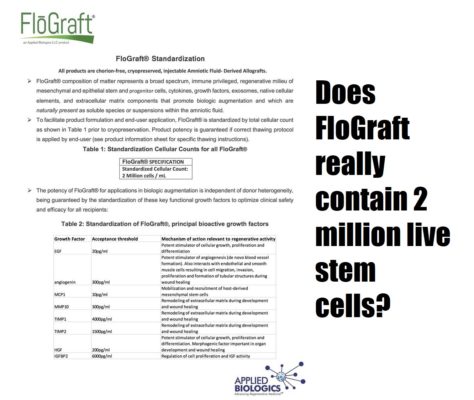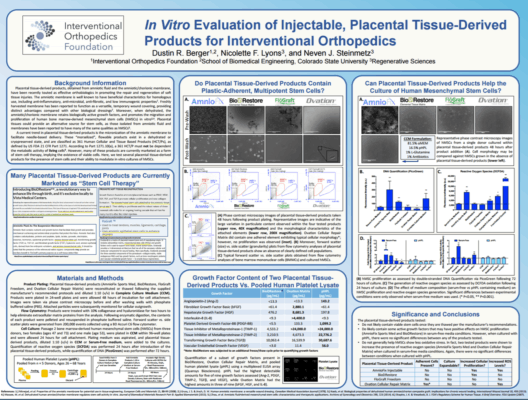FloGraft Review: Does This Product Contain Live Stem Cells?
Below is a product handout from FloGraft, one of the many amniotic products being used by physicians who claim to be injecting live amniotic stem cells. It makes many claims about this product, including the suggestion that it has live stem cells. However, testing by a third-party nonprofit showed nothing living, let alone stem cells. So let’s review the document and the ruse.

Amniotic Stem Cells and the Birth-Tissues Industry
I’ve blogged many times about the ethically challenged birth-tissues industry. As matrix and growth-factor products, these products likely have a niche place in helping physicians treat orthopedic injuries. However, I’ll never forget the sales rep selling PRP and stem cell kits as well as amniotic tissues who told me that most of the physicians he called upon were just too lazy to want to take blood or bone marrow to treat patients with PRP or stem cells. They wanted something that had stem cells that could stay on the shelf. This same sales rep is the one who sent me a vial of amniotic fluid that he knew had live stem cells because the company told him so. However, once we tested it in our lab, it didn’t have a living thing, let alone stem cells.
Sales Reps, Illegal Marketing Material, and Doctors
Right now, the FDA prohibits the sale or marketing of any product from a donor that has living cells unless that product has a full drug approval. The problem is, of course, that none of these birth-tissue products has a full drug approval, but instead they have a simple tissue registration requiring no clinical data. So any piece of written marketing material about amniotic tissue that claims it has living cells that could be involved in tissue repair is a document that violates FDA rules. However, that hasn’t stopped many companies from having sales reps tell physicians verbally that their products contain live cells. So what does this document say?
The FloGraft-Sales White Paper
First, the document above says, “FloGraft…represents a broad spectrum of immune privileged, regenerative milieu of mesenchymal and epithelial stem and progenitor cells…”. Huh? Right off the bat, the white paper claims that FloGraft has mesenchymal stem cells from a donor, making it a 351 drug and not eligible for 361 tissue registration. In addition, since only living cells can evade the immune system, given that the company has no drug approval, by placing this in writing, it has likely violated federal drug law.
Next, the company says, “…FloGraft is standardized by total cellular count as shown in Table 1…” Table 1 then says that the product has “2 Million cells/ml.” What’s interesting from my standpoint is that nowhere does it say that these cells are living. Obviously, any reasonable reader would conclude that no company would talk about mesenchymal stem cells and the fact that its product has two million total cells if the cells were dead.
Does FloGraft Have Living Mesenchymal Stem Cells?
The Interventional Orthopedics Foundation paid for FloGraft vials and tested for viability. It found no living tissue and certainly no mesenchymal stem cells capable of surviving in culture under ideal growing conditions. Click on the graphic below for more information about those tests. Interestingly, nowhere on the white paper does it say that FloGraft has living cells, but there is an inference that they are living because they are “immune privileged.” So this may be the ruse. Create a document that the average reader will assume means that the product has living cells, but then never overtly state anywhere in the document that the cells are living, alive, or viable. Hence, if you get called on the FDA carpet, you can claim that nowhere does the document expressly say that there are living cells.
The upshot? The FloGraft document is representative of the entire birth-tissues industry. In order to sell this stuff for top dollar (about 1M a delivery), the companies must give doctors the impression that there are living stem cells in the product. However, if they’re caught doing that by the FDA, then they can get in deep trouble. Also, given that all of our tests to date have shown that these products are all dead tissue, the companies have another challenge: how to make these products appear “alive.”
How have we all sunk so low in regenerative medicine? I applaud all of the physicians on the LinkedIn Biologic Orthopedic Society who jumped in to condemn this type of bait-and-switch advertising as that’s the first step in recovery—recognizing that you have a problem!
____________________________________________________________
4/27/24 Update-Apex has reached out to us and relayed that they no longer sell this product.

If you have questions or comments about this blog post, please email us at [email protected]
NOTE: This blog post provides general information to help the reader better understand regenerative medicine, musculoskeletal health, and related subjects. All content provided in this blog, website, or any linked materials, including text, graphics, images, patient profiles, outcomes, and information, are not intended and should not be considered or used as a substitute for medical advice, diagnosis, or treatment. Please always consult with a professional and certified healthcare provider to discuss if a treatment is right for you.

